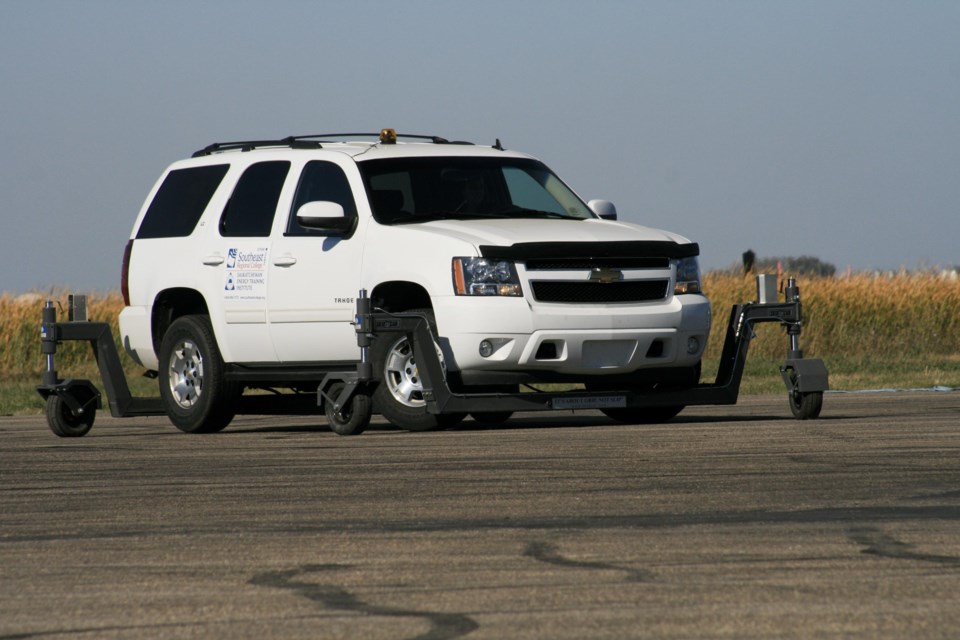If you love winter driving that much, you may want to experience those icy conditions all year, and there is one place to go in Estevan to get slippery road conditions year round: the Estevan Airport.
The Saskatchewan Energy Training Institute (SETI) now uses the open pavement at the airport to train drivers how to handle their vehicles in a number of conditions, including ice, rain and gravel-road driving. The one-day skid training has been offered for the last seven months through the Southeast Regional College, and so far they have completed two sessions with clients from Alberta and have another set up in October.
Ken Shackel, a TransCanada training consultant with SETI, said the training will benefit any company that has employees who do a lot of driving in company vehicles. He noted they began offering the local training because of a need that's been identified in the area.
"We knew the demand was there, and we felt it would increase, just with all the activity in the area," he said. "There are more and more companies with people on the road. We knew there was an opportunity to build. Now we're able to do this training locally."
Shackel said they have a great relationship with the airport, and the only "hiccup" is that they need to keep one extra staff person, who is trained as a radio operator, at the airport to communicate with planes coming in. He said the perfect conditions for the training are worth it though, as the pavement never has a puddle or gravel on it.
They are setting up training locations in Weyburn, Carlyle and Manitoba as well.
He said the training can benefit any company that has employees doing a lot of driving.
"It's really anyone who's offering any kind of fleet of vehicles. Any company operating a fleet of vehicles is excellent for this. The drivers in this program are all experienced drivers. Primarily they're working for a company, and they're driving a company vehicle."
He said what a company needs to recognize is the value of the employee as well as collateral interests.
"There's a $40,000 to $50,000 truck with the company logo emblazoned all over it. If they're in any kind of accident, you've got downtime for the employee possibly, downtime for the vehicle and then you've got the costs, like whatever that does to your insurance," said Shackel.
In Estevan, the SKIDCAR system has been installed on a modern 4x4 SUV with electronic stability control that can be switched on and off, and is hooked up to outriggers on all four corners of the vehicle. Controls for the outriggers are in the front of the vehicle and can be used by either the driver or front passenger.
The outriggers are operated via an hydraulic system, that raises and lowers the front wheels, rear wheels or both, simulating a different situation. When the back of the vehicle is raised, traction is lowered from the back tires and fishtailing is simulated. When traction on all tires is reduced, the dry and bare pavement underneath can feel very slippery indeed.
Training has previously been done in cold weather on frozen lakes. The new SKIDCAR allows training year round.
Brenda McPhedran is one of three driving instructors, and was in the SKIDCAR during the demo day that SETI hosted at the airport Sept. 27. She said they teach a number of driving techniques during the one-day course. She noted that the first thing they often need to do is teach people to drive from the bottom of the steering, rather than the traditionally-taught 10 and two or nine and three hand positions.
With hands on the bottom of the steering wheel, a driver's hands won't be blasted into his or her face if the air bag were to deploy in an accident.
The training is typically done at speeds between 20 and 40 kilometres per hour, and the course is set up as a simple figure eight as the driver moves inside pylons. After manoeuvring the course a couple of times, McPhedran will take traction away from the front wheels, followed by the rear, and then all four. She will also toggle the vehicle's built-in stability control system to allow the driver to feel the differences of control when it is turned on.
The vehicle is very portable, so Shackel said the training isn't necessarily required in their own facilities. They can take the SKIDCAR to a company's lot or work site, as long as there is enough good pavement to run the course.
Training can be booked through the campuses in Estevan, 637-4931, and Weyburn, 848-2500.




